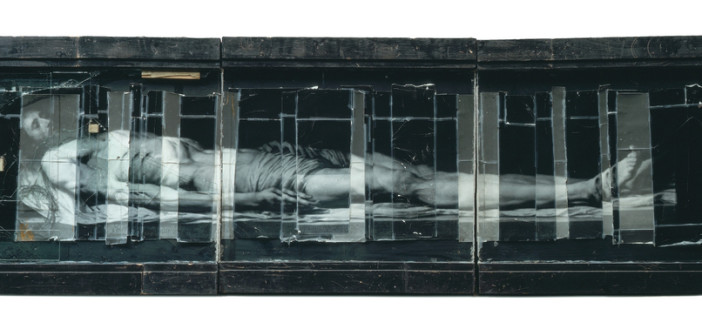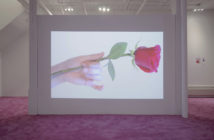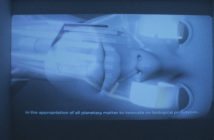If there is a clear divide of visual and sonic resonance, it’s in "The End is Near." A diagonal partition partially cuts the room, but leaves space on either end. On one side are paintings that tread high formalism, and on the other, works by Christian Marclay and the Starn Twins that riff on both action and renaissance painting. The Starn Twins’s Christ (Stretched) (1985—1986) references the grittiness and immediacy of punk culture as it does anything else, and Marclay’s Ghost (I don’t live today) (1985) expresses the shrillness of the music itself. Near these works is Raymond Pettibon’s No Title (I don’t know why) (1985), which, as Molesworth writes "strip[s]away modernist hierarchies of high and low culture and instead offer all the linguistic detritus of culture with radical parity."1 With Marclay’s sonorous Ghost comingling with Chomsky or Rosler, the contradictions of culture, both high and low, of the 1980s is perhaps no better amplified than here.
In my article, "9pm to 5am: Underground Boston and Mark Morrisroe," published in last month’s journal, I attempted to give context to the significant work created by Boston’s "other school." This school came of age in the late 1970s and early 1980s, and fluidly exploited painting, photography, and performance in order to explore the nexus of desire and sexuality, and how those formulated memory and identity. Like New York, Boston then was a city in flux. The Combat Zone was wiped out of downtown in the mid-1970s, heralding a new era of urban renewal, gentrification, and corporatization. Barney Frank was first elected to the Massachusetts House of Representatives in 1972, as a closeted gay man. This January Frank will leave the House after forty years in office; last July he married his long-time partner. This Boston of transition, a city that grappled with New Urbanism and poverty relocation (instead of reduction), served as an experimental hub for young artists then at MassArt or the Museum School, such as Christian Marclay, the Starn Twins, Mark Morrisroe, or Gail Thacker.
"The backwater Boston of Mark Morrisroe’s childhood is disappearing now: its grungy alleys, the kitschy Kon-tiki bar and retro coffee spots, the mom-and-pop junk shops, the seedy, furtive S&M bars of the ‘Combat Zone,’ the all-night horror film fests, and the oddball, salty neighborhood characters he loved have vanished," writes Megan "Montana" Smith in Mark Morrisroe: Memento Mori.2 A memoir in words and pictures, Smith’s Memento Mori brilliantly sketches this by-gone Boston, vividly conjuring life around the Museum School. Smith went to the Museum School with Mark, Gail Thacker, and Pat, and hung around Steve Stain and Human Sexual Response. She recalls the Museum School as a "fertile social and intellectual melting pot,"3 and in her essay, she vividly describes the integrating orbits of art students, musicians, street kids, sex workers, and regular college kids that formulated Morrisroe’s Museum School. Smith wrote her book, which she published earlier this year and hopes to reissue to a wider audience, because she thought that certain aspects of Morrisroe’s biography have been ignored. Memento Mori includes just some of Smith’s hundreds of photographs that document their life and times around Boston. All in black and white, there’s a candor and simplicity to these photos, which lends to a certain "time-capsule" effect; that, coupled with her use of Morrisroe’s particular slang, marks this book as a unique addition to the growing critical literature surrounding the Boston School, and Morrisroe especially. But in my article last month, I don’t reference Smith, or her book, and that’s because sadly, I simply didn’t come across her in my research.
 Doug + Mike Starn
Doug + Mike StarnChrist (Stretched), 1985-86
Toned silver print, tape, wood, plexiglass
28 x 142 x 45 inches
Collection of Stephen Mindich and Maria Lopez
I don’t discuss Marclay or the Starns in "9pm to 5am," either. The Starn Twins directly affected Morrisroe’s Boston, both as a student and emerging artist. Ramsey McPhillips, Morrisroe’s last lover, writes that the Starns "took many of their cues from Mark,"4 and that they stole the show at the ICA’s 1985 Boston Now, Photography exhibition with their ripped and taped large-format photographs. "Many thought that they had stolen the idea from Mark," writes McPhillips. "Mark never thought so. He was just furious that they had taken the limelight away from him and that he was being usurped by not one, but two beautiful men . . . Mark and the Starns took turns posing for each other, an act at the Museum School that would be synonymous with becoming blood-brothers."5 However, I didn’t discuss this bond, or the correlation between Marclay and Morrisroe, though it certainly shaped 1980s Boston. Partly because to do so was beyond the scope of an article and partly because I wanted to reclaim the limelight for Mark within the context of an ICA exhibition.
No one tried to push Mark into the spotlight more than Pat Hearn. Pat was, as McPhilips writes, Mark’s "artistic patron saint, his fantasy dominatrix, the Jackie-O doll he reviled, the Combat Zone stripper he created, the mother he always wanted but never had . . . No one was more shocked by Mark’s death than Pat Hearn."6 Roberta Smith called Hearn a "pioneer of the art scene in the East Village, SoHo, and Chelsea,"7 as she had gallery spaces in each of those neighborhoods, long before it was popular or trendy. Pat showed Mark’s work in her gallery throughout the 1980s, even after her critical and commercial successes garnered her opportunities to work with mega-artists and collectors. In 1986 she staged a solo exhibition of Mark’s sandwich prints, Polaroid negatives, and photograms; two years later, when Mark was very sick, she staged another solo show of his work, this time incorporating the x-ray photograms that he had made in his hospital dark room. Pat was Mark’s heir and executor, and after he died, devoted much of her time to organizing and cataloguing his artistic remains. In 1994 she showed Mark’s work in Survey of the Estate. She also approached the ICA/Boston about showing Mark’s work in a retrospective, but "as an institution we understood that Mark wasn’t necessarily famous enough to do a show composed solely of the estate,"8 said former ICA-curator and Participant, Inc. founder Lia Gangitano. Thus the project evolved to 1995’s Boston School exhibition, with Mark Morrisroe (1959—1989) A Survey from the Estate installed on the museum’s upper floor. With help from Pat, Gangitano curated Boston School with Milena Kalinovska, and recalls:
The portion of the exhibition devoted to Mark was really in Pat’s head, as if she had imagined that exhibition for a long time, and it was like watching the exhibition unfold as her memory of Mark. I vividly recall the installation process, which very much resisted any chronological sequence. As she arranged the pictures she deliberately did not want to come to a conclusion; it was a story that felt as if it continued when it got to the end. It was a moving experience for me to see her construct a story without an end for Mark.
When Pat died in 2000, that story might have died, too. Mark’s estate landed in the lap of Colin de Land, Hearn’s widower, but then he died in 2003. The Morrisroe estate was purchased by the Ringier Collection in 2004, to be housed for public use at the Fotomuseum Winterthur. Archivist Teresa Gruber only recently completed the organizational work that Pat started back in the early 1990s. Thus many people, friends of Mark and Pat, as well as museum professionals, such as Gangitano and Gruber, have contributed to how Mark and his archive are understood today.
Even Pat’s groundbreaking work, as a dealer, curator, and artist, risked historical obscurity. While a trove of de Land’s documentative photographs were stashed at the Archives of American Art, (many were actually published in Colin de Land, American Fine Arts, a 2008 book that included memorial vignettes contributed by Pat and Colin’s friends), Pat’s output was scattered until now. On November 8, the CCS Bard Library and Archive announced their acquisition American Fine Arts, Co., and the Pat Hearn Gallery archives. The acquisition includes exhibition history and documents, correspondence, personal journals, and memorabilia. This material will be available to CSS Bard students, as well as visiting scholars and curators after it’s processed. This therefore ensures that de Land and Hearn’s very significant contributions will be materially preserved and theoretically instituted within the art historical discourse.
"Any institution that overlooks the ground on which it standing is veering towards the more challenging definition of what an institution is," Mike Carroll told me last summer. "Their resources are to find the slippery thing, the thing that is receding and emerging." The ICA hasn’t ignored Morrisroe or the Boston School in This Will Have Been; tucked neatly inside the Mediateque, which separates the exhibition from the permanent collection, is a small showing of institutional archival material, posters, correspondence with artists, and other museum ephemera.
Photomontage
11 x 14 inches
Courtesy of the artist, Rhode Island
© Deborah Bright
This is by far the quietest section of the exhibition, and I can’t make up my mind about it. On the one hand I think it’s great that the ICA acknowledges the Boston scene. On the other, the way that they are doing it feels de-contextualized, sterile, and abbreviated. With This Will Have Been, the thing that is emerging is a comprehensive history of 1980s art, from a global perspective. What’s receding, and dangerously so, is the particular history of 1980s Boston artists and their alternative spaces that they developed and developed within.
I felt absolutely disconnected from contemporary art when I moved from New York to Boston two years ago. When Art in America ran Mark Morrisroe as their cover story in their March 2011 issue, I couldn’t believe what I read: Boston produced Mark and Pat. Desperate to discover their Boston, I trolled the internet and libraries, reading everything I could about them, their lives, and their times. When This Will Have Been was announced I was elated, thinking I’d finally see some Morrisroes in a museum; and less than a mile from where he had his first show at the 11th Hour! I was quickly disappointed when I didn’t find him among the included artists. I hope that in "9pm to 5am," I give evidence of the precedent of contemporary art-making in Boston, because that’s why I wrote it. I hope that Boston’s young art historians, would-be-dealers, and emerging artists take as a lesson how Boston can incubate significant work, as I have.
[1] Helen Molesworth, This Will Have Been: Art, Love and Politics in the 1980s (Museum of Contemporary Art Chicago in association with the Yale University Press, New Haven and London, 2012, exh. cat., at ICA/Boston November 15, 2012—January 27, 2013), p 24.
[2] Megan "Montana" Smith, Mark Morrisroe: Memento Mori, a photographic memoir, Blurb, 2012, 15.
[4] Ramsey McPhillips, "Who Turned Out the Limelight? The Tragi-Comedy of Mark Morrisroe," in Loss Within Loss: Artists in the Age of AIDS, edited by Edmund White (University of Wisconsin Press, Madison, 2001) p. 107.
[3] Smith, 10.
[5] McPhillips, 107.
[6] McPhilips, 100.
[7] Roberta Smith, "Pat Hearn, Art Dealer in New York, Dies at 45," New York Times August 20, 2000, accessed April 24, 2012.
In "Mark Morrisroe, A Conversation," Mark Morrisroe (Fotomuseum Winterthur, Winterthur, Switzerland, 2010, exh. cat., November 27, 2010-February 13, 2011) p. 351.
[8] Lia Gangitano, "Mark Morrisroe, A Conversation," Mark Morrisroe (Fotomuseum Winterthur, Winterthur, Switzerland, 2010, exh. cat., November 27, 2010-February 13, 2011) p. 352.





